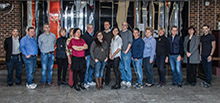Department Colloquia
Spring 2023 Schedule
Talks will be via Zoom, or in hybrid mode (on Zoom with an in-person option) where indicated. Zoom registration links will be displayed below, alongside each scheduled talk. Check here for updates to the schedule as the semester progresses. In particular, look out for new upcoming series of "In Conversation" events, in which guest speakers discuss their career progression after completing a physics degree.
Tuesday, January 31, 12:30 p.m.
Title: Jung, Pauli and Synchronicity
Speaker: Vikas Nanda (Rutgers University)
Venue: Zoom
Abstract: Collagens are the most abundant proteins of the extracellular matrix, and the hierarchical folding and supramolecular assembly of collagens into banded fibers is essential for mediating cell-matrix interactions and tissue mechanics. Collagen extracted from animal tissues is a valuable commodity, but suffers from safety and purity issues, limiting its biomaterials applications. Synthetic collagen biomaterials could address these issues, but their construction requires molecular-level control of folding and supramolecular assembly into ordered banded fibers, comparable to those of natural collagens. I will discuss the design and characterization of a class of banded fiber-forming synthetic collagens that recapitulate the morphology and some biological properties of natural collagens.
Thursday, March 2, 12:30 p.m.
Title: TBC
Speaker: Visiting Guest (TBC)
Registration link: TBC
Abstract: TBC
Thursday, March 9, 12:30 p.m.
Title: An Astronomical Simulation Device From Ancient Greece: the Antikythera Mechanism
Speaker: Alexander Jones (New York University)
Venue: Zoom only (link TBC)
Abstract: TBC
Thursday, March 23, 12:30 p.m.
Title: TBC
Speaker: Christian Beneš (Brooklyn College, Mathematics Department)
Venue: Hybrid (venue and matching Zoom link TBC)
Abstract: TBC
Tuesday, April 4, 12:30 p.m.
Title: TBC
Speaker: Karl Sandeman (Brooklyn College, Physics)
Venue: Hybrid (venue and matching Zoom link TBC)
Abstract: TBC
Early May (date TBC)
Title: Gamma Rays in Globular Cluster
Speaker: Owen Henry (Brooklyn College, Physics)
Venue: Hybrid (venue and matching Zoom link TBC)
Abstract: TBC
More Information
Please direct any enquiries to Karl Sandeman.






